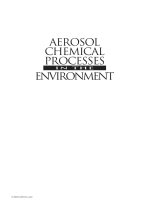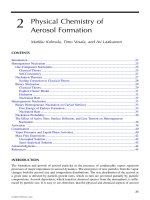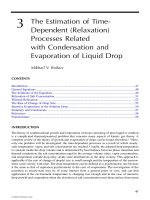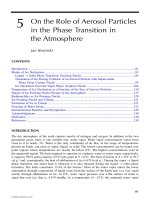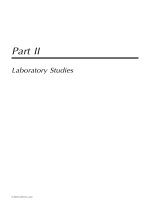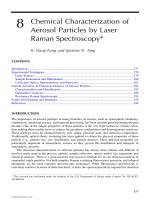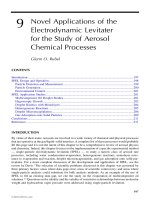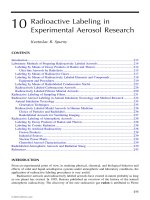AEROSOL CHEMICAL PROCESSES IN THE ENVIRONMENT - CHAPTER 8 pdf
Bạn đang xem bản rút gọn của tài liệu. Xem và tải ngay bản đầy đủ của tài liệu tại đây (607.65 KB, 19 trang )
177
8
Chemical Characterization of
Aerosol Particles by Laser
Raman Spectroscopy*
K. Hang Fung and Ignatius N. Tang
CONTENTS
Introduction 177
Experimental Techniques 179
Laser Sources 179
Sample Generation and Illumination 180
Collection Optics, Spectrometers, and Detectors 181
Current Advances in Chemical Analyses of Aerosol Particles 182
Characterization and Identification 182
Quantitative Analyses 188
Resonance Raman Spectroscopy 191
Future Development and Summary 193
References 194
INTRODUCTION
The importance of aerosol particles in many branches of science, such as atmospheric chemistry,
combustion, interfacial science, and material processing, has been steadily growing during the past
decades. One of the unique properties of these particles is the very high surface-to-volume ratios,
thus making them readily serve as centers for gas-phase condensation and heterogeneous reactions.
These particles must be characterized by size, shape, physical state, and chemical composition.
Traditionally, optical elastic scattering has been applied to obtain the physical properties of these
particle (e.g., particle size, size distribution, and particle density). These physical properties are
particularly important in atmospheric science as they govern the distribution and transport of
atmospheric aerosols.
The chemical characterization of airborne particles has always been tedious and difficult. It
involves many steps in the process, namely, sample collection, species and/or size separation, and
chemical analysis. There is a great need for non-invasive methods for
in situ
chemical analysis of
suspended single particles. For bulk samples, Raman scattering fluorescence emission, and infrared
absorption are the most common spectroscopic techniques. While fluorescence spectroscopy is
extremely sensitive in terms of detection limit,
1
it lacks the spectral specificity required for chemical
* This research was performed under the auspices of the U.S. Department of Energy under Contract No. DE-AC02-
76CH00016.
L829/frame/ch08 Page 177 Monday, January 31, 2000 3:06 PM
© 2000 by CRC Press LLC
178
Aerosol Chemical Processes in the Environment
speciation. Furthermore, this technique can only be used for materials that fluoresce in the visible
region and, therefore, is quite limited as an analytical tool for general application. Infrared spec-
troscopy has successfully been applied to chemical characterization of the organic and inorganic
species in size-segregated aerosol samples collected on impactor plates.
2
Deposited single particles
can also be analyzed by infrared microscopy.
3
On the other hand, although Arnold and co-workers
4-7
have obtained infrared spectra of levitated single aqueous droplets, the infrared absorption of the
species is not directly measured in the experiment. Instead, the Mie scattering from the droplet is
monitored and the size change due to evaporation as a result of infrared absorption is detected.
The experiment is interesting but rather involved. It is difficult to adapt this technique to routine
particle analysis because it requires the particle to be spherical in shape and to change size by
evaporation during infrared absorption.
Despite the inherent low scattering cross-section of the spontaneous Raman scattering process,
Raman spectroscopy has been used rather successfully in particle analysis. In contrast to fluores-
cence emission and infrared absorption techniques, Raman scattering can be applied to optically
opaque, irregular-shaped samples. It is also ideally suited for microscopic samples as well. More-
over, it delivers rich vibrational molecular information that is comparable to infrared spectroscopy
for identification purposes. The use of the Raman microprobe is a well-established method for
analyzing samples collected on a substrate. Early work in this research area was led by Rosasco
and co-workers.
8-12
Aerosol particles were collected on a filter substrate at first. Then the sample
was illuminated by a high-power laser. Various type of compounds, such as inorganic minerals and
carbonaceous materials, were analyzed by this technique. Adar and co-workers
13,14
have subse-
quently developed a highly automated micro/macroRaman spectrometer. The sensitivity and signal-
to-noise ratio of the instrument are high enough to enable a spatial resolution of one micron.
However, there was still a lack of suitable measurement techniques for
in situ
chemical
characterization of a levitated particle containing only about 10
12
molecules. Thurn and Kiefer,
15,16
in an effort to develop a microprobe technique for suspended particles, have obtained Raman spectra
of optically levitated glass particles. The optical levitation of a particle was first demonstrated by
Ashkin and Dziedzic.
17
This is, in essence, a turning point for the application of Raman spectroscopy
in aerosol research.
18-25
Raman spectroscopy of aerosol particles has several interesting properties
that are of special interest to aerosol science. The morphology-dependent optical resonances that
occur in the Mie scattering of dielectric spheres can interact with the Raman scattered photons.
This interaction leads to two physical processes. At the low energy field regime, the simple Mie
resonance can interfere and sometimes mask the Raman frequencies.
26
The overall inelastic scattered
signal can be viewed as a linear summation of the spontaneous Raman scattering and the morphol-
ogy-dependent Mie resonance. The Mie interference diminishes for larger spheres, as the resonance
peaks become lower in amplitude and higher in numbers per spectral bandwidth. At the high energy
regime, stimulated Raman emissions can be generated.
27-29
The Mie resonance peaks provide a high
Q-factor for the Raman scattered photons to amplify coherently, and the intensity of the stimulated
Raman peaks depend exponentially on the Q-factor of each Mie resonance peak. The stimulated
Raman scattering is a nonlinear process, whose intensity is given by
(8.1)
where
I
s
is the spontaneous Raman intensity,
g
s
is the gain factor,
I
i
is the incident laser intensity,
and
z
is interaction path length. Mie resonances thus affect the stimulated Raman in two ways.
First, the pump path for the laser through the interaction volume is lengthened, typically from the
physical size of the particle of a few microns to several meters. The second effect is on the gain
factor of the stimulated Raman scattering.
57-59
This gain factor is proportional to the number density
of the Raman active species that are present in the particle. The effective number depends again
on the particular Mie resonance peak. Despite the nonlinearity of the intensity in stimulated Raman
II gIz
sr s s i
=
()
exp ,
L829/frame/ch08 Page 178 Monday, January 31, 2000 3:06 PM
© 2000 by CRC Press LLC
Chemical Characterization of Aerosol Particles by Laser Raman Spectroscopy
179
scattering, some quantitative measurements have been carried out with streams of solution droplets,
containing nitrates, sulfates, and phosphates.
28-30
Resonance Raman scattering is another area of much interest to aerosol characterization. The
resonance Raman effect arises when the incident laser frequency is chosen to approach or fall
within an absorption band. There are several features that set the resonance Raman scattering
technique apart from the spontaneous Raman scattering technique. The most important feature is
it capability to probe extremely low concentration samples. However, due to absorption of the
incident photons, the sample medium is no longer transparent, resulting in unwanted effects such
as fluorescence and heating. In the condensed phase, fluorescence is much reduced by quenching
and thus may not constitute an overwhelming problem as it would in the gas phase. Nevertheless,
the heating effect is still formidable and this requires special sample-handling techniques for bulk
media,
31
as well as aerosol particles.
32,33
This chapter reviews the recent advances in the chemical and physical characterization of
suspended single particles by laser Raman spectroscopy. Many of the current experiments outfitted
with the state-of-the-art instrumentation are described. Various types of experimental set-ups for
aerosol laser Raman spectroscopy are discussed in detail. The detection limits and the analytical
applications of the spontaneous Raman and resonance Raman scattering are described and discussed
at length. The limitations and future expectations of the Raman techniques in the field of aerosol
research are also given.
EXPERIMENTAL TECHNIQUES
A variety of experimental set-ups with different lasers, particle containment chambers, and optical
detectors have been used to measure Raman scattering from aerosol particles. It is best to divide
the methodologies into two categories. One is the single-particle suspension method and the other
is the monodisperse particle stream. These two sampling methods are most frequently used in
Raman scattering experiments today.
Although commercial Raman microprobe systems are readily available, many of the aerosol
Raman experiments are based on the needs of individual experiments. As a result, only the
monochromator and detector components are obtained directly from commercial suppliers without
any modifications. In general, an aerosol Raman experiment is designed with specific analytical
purpose and the apparatus is built on a modular design basis for maximum flexibility.
L
ASER
S
OURCES
Currently, there is a wide range of commercially available lasers suitable for aerosol Raman
scattering experiments. For spontaneous Raman scattering, the most frequently used continuous
wave (CW) laser is the argon-ion laser. The argon-ion laser typically provides a line-tunable source
in the visible and the near-ultraviolet regions. The wavelengths and their relative powers are
tabulated in Table 8.1. The argon-ion laser is chosen for aerosol Raman experiments because it has
several high-powered laser lines in the blue and green regions of the visible spectrum. Raman
emission from these excitation lines fall within the maximum sensitivity region of most optical
detectors. Even molecules with very large Raman frequency shifts, such as the OH band in a water
molecule (3200 cm
–1
), can be covered with these optical detectors. In contrast, a krypton-ion laser
has nearly as high single-line output powers as the argon-ion laser; however, it has its high-power
output lines in the red region (i.e., at 6470.88 Å and 6764.42 Å). Consequently, the typical Raman
shifted symmetric vibrational bands for the inorganic and OH groups would appear near 7000 Å
and 8200 Å, respectively, making the krypton laser less desirable. Moreover, the Raman scattering
cross-section increases with frequency. Therefore, the blue region in the visible is spectrally most
suitable for Raman excitation. For stimulated Raman scattering experiments, the most widely used
laser for excitation is the solid-state YAG pulsed laser. The second harmonic line of the YAG laser
L829/frame/ch08 Page 179 Monday, January 31, 2000 3:06 PM
© 2000 by CRC Press LLC
180
Aerosol Chemical Processes in the Environment
at 5320 Å produces a stable and high-power output that is well-suited for stimulated Raman
scattering. The third harmonic line is less frequently used than the 5320 Å line. The reason for its
low popularity is twofold: (1) this line is higher in photon energy, and thus, increases the probability
of multiphoton ionization, and (2) Rayleigh scattering presents some technical problems because
the availability of optical filters for the ultraviolet region is still quite limited.
S
AMPLE
G
ENERATION
AND
I
LLUMINATION
The most important consideration for sample containment and illumination is the efficiency of the
optical elements involved. The physical dimensions of the particle containment chamber and the
vibrating orifice particle generator are usually the determining factors for how the laser beam should
be focused when only one laser beam is considered as the sole source for illumination, the minimum
focal spot size of the beam for a diffraction-limited beam waist can be easily calculated.
34
The spot
diameter is given by
(8.2)
where
d
1/
e
,
D
1/
e
,
λ,
and
f
are the spot diameter, laser beam diameter, laser wavelength, and focal
length, respectively. For a typical argon-ion laser with
D
1/
e
= 2 mm, at 4880 Å and 10 to 15 cm
focal length, the spot diameter is between 20 to 30
µ
m. Thus, in the laboratory, suspended particles
in the 15-
µ
m diameter range can be easily illuminated by this beam. On the other hand, the pulsed
YAG laser generates a laser beam with diameter equal to about 9 mm in the second harmonic.
Therefore, the corresponding spot size is about 5 to 7
µ
m.
The most commonly used single-particle containment technique is the quadrupole electrody-
namic suspension. A schematic diagram is shown in Figure 8.1. It consists of two dc endcaps and
TABLE 8.1
Spectral Characteristics of
Commonly Used Lasers
Argon-ion laser lines:
Wavelength (Å) Relative Intensity
3511.12 0.01
3637.78 0.01
4545.05 0.07
4579.34 0.18
4657.89 0.07
4726.85 0.10
4764.86 0.36
4879.86 0.93
4965.07 0.28
5017.16 0.18
5145.31 1.00
Krypton-ion laser lines:
Wavelength (Å) Relative Intensity
5208.31 0.14
5308.65 0.40
5681.88 0.20
6470.88 1.00
6764.42 0.24
dfD
ee11
4
//
,=
()
()
πλ
L829/frame/ch08 Page 180 Monday, January 31, 2000 3:06 PM
© 2000 by CRC Press LLC
Chemical Characterization of Aerosol Particles by Laser Raman Spectroscopy
181
an ac ring electrode. The dc field balances the particle against the gravitational force and the ac
field maintains the particle at the center of the cell. A detailed description of the principles is given
by Frickel et al.
35
Since the introduction of this quadrupole electrodynamic cell concept, there have
been several modifications and variations of this design. Davis et al.
24,25
and Ray et al.
36
have used
two ac ring electrodes with a dc offset over a glass tube to maximize the collection angle for Raman
scattering and fluorescence experiments. Arnold et al.
6
have used a spherical void design to
maximize the light collection efficiency.
In resonance Raman and stimulated Raman experiments, particles no longer suspended in
electrodynamic cells. Instead, a stream of droplets are continuously generated by the Berglund-Liu
vibrating orifice particle generator.
37
This piezoelectric vibrating orifice is made commercially
available by TSI (Minneapolis, MN). The feed mechanism in the commercial model consists of a
solution reservoir and a syringe pump. The flow rate is found to be uneven when highly monodis-
perse particles are desired. Snow et al.
27
and Lin et al.
38
showed that the reservoir can be pressurized
by a compressed inert gas such as nitrogen to maintain a steady liquid flow, thus eliminating the
use of the syringe pump. In addition, a high throughput, submicron-pore size solution filter can
greatly enhance the stability of particle generation.
C
OLLECTION
O
PTICS
, S
PECTROMETERS
,
AND
D
ETECTORS
The collection optics and spectrometer should always be considered together in aerosol particle
Raman scattering experiments. The size of the scattering source is very often the physical diameter
of the particle that is imaged onto the entrance slit of the spectrometer. There are two aspects
critical for the collection optics that are very important; namely, the magnification of the image
and the desired resolution of the Raman spectrum. Assume that the
f
-numbers of the collection
optics and the spectrometer are
f
1
and
f
2
, respectively. Then, the magnification of the particle image
with 100% transmission at the entrance slit would be
(8.3)
However, the slit width, which limits the spectrometer resolution, must be set to at least a size of
Md
in order to transmit the entire particle image (
d
is the diameter of the particle). Therefore, the
larger the particle, the lower the resolution one can obtain for a given dispersion of the spectrometer.
FIGURE 8.1
Schematic diagram of the experimental set-up for single-particle Raman spectroscopy.
Mff=
21
.
L829/frame/ch08 Page 181 Monday, January 31, 2000 3:06 PM
© 2000 by CRC Press LLC
182
Aerosol Chemical Processes in the Environment
On the other hand, the best approach for high resolution in Raman scattering experiments is to use
a spectrometer with high dispersion, which requires the use of both large grating and/or high groove
density. This is because the product,
Md
, is fixed and the resolution of the spectrometer can only
be increased by increasing the resolution of the grating.
In practice, Raman experiments require photon-counting techniques that yield the minimum
noise level. Although some experiments are still carried out with photomultipliers, most recent
experiments are carried out with more efficient detectors, such as the intensified photodiode and
charged-coupled device (CCD) array detectors. These modern detectors offer an array approxi-
mately 25 mm long. The spatial resolution at the image field is in the vicinity of 22 to 25
µ
m.
Considering the fact that the entrance slit of a typical spectrometer is normally set between 100
and 150
µ
m to accommodate the image of the aerosol particle, these array detectors thus serve the
purpose very effectively. The spectral ranges of these detectors are comparable to those of photo-
multipliers; they can reach from 250 nm in the ultraviolet to 1100 nm in the infrared. A personal
computer is currently a necessity for online control of both the spectrometer and the array detector,
as well as for data acquisition and analysis.
There is a major difference between intensified array and non-intensified array detectors. The
intensifier resembles a photomultiplier and therefore has intrinsic dark counts. The addition of dark
counts due to the intensifier limits the exposure time for the array detector. However, the intensifier
can be gated, or turned on momentarily in a pulsed laser experiment; hence, the dark counts are
substantially reduced. Furthermore, the CCD detector can be cryogenically cooled to the point
where the dark count is nearly zero. Therefore, the CCD detectors are extremely well-suited for
very low signal level experiments. The CCD detectors have one intrinsic problem: namely, being
subject to cosmic ray interference. As a result, the spectra obtained from long-time exposure of
CCD arrays always contain numerous random high-intensity spikes due to cosmic rays. These
spikes are typically one to two channels in width and can be numerically removed by software
routines.
CURRENT ADVANCES IN CHEMICAL ANALYSES OF
AEROSOL PARTICLES
The application of laser Raman spectroscopy in the field of aerosol research has steadily grown
during the past decade. Although the work published in the literature covers a vast array of topics,
it is helpful to categorize them into three general areas that hold special interests for aerosol
researchers. These three areas are: (1) physical and chemical characterization of aerosol particles,
(2) quantitative analyses by Raman spectroscopy, and (3) the development of resonance Raman
spectroscopy for aerosol particles.
C
HARACTERIZATION
AND
I
DENTIFICATION
OF
A
EROSOL
P
ARTICLES
Aerosol particles of inorganic salts in the crystalline state usually exhibit characteristic Raman
frequency shifts with a very narrow bandwidth; whereas, in solution, the corresponding Raman
frequency shifts are slightly displaced and the peaks are broadened by molecular motion.
21,39,40
A
typical example is shown in Figure 8.2, where the Raman spectra taken of a sodium nitrate (NaNO
3
)
particle (a) as a solution droplet, (b) during phase transformation from liquid solution to solid state,
and (c) as a crystalline particle, clearly show the changes in the molecular vibrational band features
for the same particle in different physical states. The observed Raman shifts at 1051 cm
–1
for the
free nitrate ion (NO
3
–
) in aqueous solution droplets and at 1067 cm
–1
for NaNO
3
crystalline particles
are in good agreement with the literature data obtained for bulk samples. The measured linewidth
for the droplet is typically 6 cm
–1
, compared with only 2 cm
–1
for the solid particle. Thus, the
L829/frame/ch08 Page 182 Monday, January 31, 2000 3:06 PM
© 2000 by CRC Press LLC
Chemical Characterization of Aerosol Particles by Laser Raman Spectroscopy
183
Raman shifts, combined with the large difference in the linewidth between the solid and liquid
states, provide a viable means for particle characterization.
Many inorganic salts in the crystalline form can exist either as anhydrous salts or as hydrated
salts containing one or more water molecules of crystallization, depending on the chemical nature
and the crystallization conditions. Ammonium sulfate is a common constituent of atmospheric
aerosols and it always exists in the anhydrous form. In bulk solutions, sodium sulfate crystallizes
below 35°C to form the stable hydrated solid, Na
2
SO
4
⋅
10H
2
O. Some inorganic salts may have
more than one stable hydrated form. Chang and Irish
41
have reported Raman and infrared studies
of hexa-, tetra-, and dihydrates of crystalline magnesium nitrate. The latter two hydrates are formed
from partial dehydration of the hexahydrate under vacuum at 30 to 40°C. However, given the
temperature extremes that can be attained in the atmosphere, most inorganic salts are not expected
to exist in more than two different crystalline forms in atmospheric aerosols. For example, mag-
nesium nitrate has two stable hydrated states that are expected to be present in ambient aerosols.
At temperatures below –20°C, it exists as Mg(NO
3
)
2
⋅
9H
2
O; and above –8°C, it exists as Mg(NO
3
)
2
⋅
6H
2
O. These two hydrates may coexist at temperatures between –20 and –8°C. The anhydrous
state and other hydrates of magnesium nitrate can only be prepared under conditions that are not
encountered in the atmospheric environment.
In order to identify the hydrated or anhydrous forms present in an aerosol particle, it is necessary
to have band resolutions better than a few wavenumbers (cm
–1
). Table 8.2 gives a list of Raman
frequencies for several common nitrates and sulfates. The proximity of these Raman vibrations
clearly illustrates the need for high-resolution spectrometers for aerosol particle analyses. For
FIGURE 8.2
Raman spectra of an NaNO
3
solution droplet undergoing phase transformation to form a
crystalline particle.
L829/frame/ch08 Page 183 Monday, January 31, 2000 3:06 PM
© 2000 by CRC Press LLC
184
Aerosol Chemical Processes in the Environment
example, the presence of anhydrous sodium sulfate (Na
2
SO
4
) or the hydrated form (Na
2
SO
4
⋅
10H
2
O)
in aerosol particles can only be confirmed with a minimum resolution of ±1 cm
–1
, which is needed
to identify the corresponding Raman frequencies of 996 cm
–1
and 992 cm
–1
, respectively.
Aerosol particles composed of inorganic salts such as chlorides, sulfates, and nitrates are
hygroscopic and exhibit the properties of deliquescence and efflorescence in humid air. These
aerosols play an important role in many atmospheric processes that affect local air quality, visibility
degradation, as well as global climate. The hydration behavior, the oxidation and catalytic capa-
bilities for trace gases, and the optical and radiative properties of the ambient aerosol all depend
crucially on the chemical and physical states in which these microparticles exist. The existence of
hygroscopic aerosol particles as metastable aqueous droplets at high supersaturation has routinely
been observed in the laboratory
42-44
and verified in the ambient atmosphere.
45
Because of the high
degree of supersaturation at which a solution droplet solidifies, a metastable amorphous state often
results. The formation of such state is not predicted from bulk-phase thermodynamics and, in some
cases, the resulting metastable state is entirely unknown heretofore.
46
Figure 8.3 shows the hydration
behavior of the Sr(NO
3
)
2
particle, where the particle mass change resulting from water vapor
condensation or evaporation is expressed in moles H
2
O per mole solute and plotted as a function
of relative humidity (%RH). A crystalline anhydrous particle, whose Raman spectrum shown in
Figure 8.4b, displays a narrow peak at 1058 cm
–1
and a shoulder at 1055 cm
–1
, was first subjected
to increasing RH (filled circles). The solid particle was seen to deliquesce at 83% RH when it
spontaneously gained weight by water vapor condensation and transformed into a solution droplet
containing about 13 moles H
2
O/ moles solute. Further growth of the droplet, as RH was again
increased, was in complete agreement with the curve computed from bulk solution data.
47
As RH
was reduced, the droplet started to lose weight by evaporation (open circles). It remained a
supersaturated metastable solution droplet far below the deliquescence point until it abruptly
transformed into an amorphous solid particle at ~60% RH. The particle retained some water even
in vacuum. The Raman spectrum of such a particle is shown in Figure 8.4d, displaying a broad
band at 1053 cm
–1
, in sharp contrast to those of the anhydrous particle and the bulk solution (Figure
8.4c). In most cases, an amorphous solid particle would continuously absorb a very small amount
of water upon increasing RH until they deliquesced at 69% RH. Once in solution, the particle
TABLE 8.2
Summary of Raman Frequencies (cm
–1
) Observed for Inorganic Salt Particles
Nitrates Sulfates Phosphates
LiNO
3
1070 Li
2
SO
4
⋅ H
2
O 1008 Na
2
HPO
4
935
LiNO
3
⋅ 3H
2
O 1056 Na
2
SO
4
996 (NH
4
)
2
HPO
4
913
NaNO
3
1067 Na
2
SO
4
⋅ 10H
2
O 992 NH
4
H
2
PO
4
913
KNO
3
1053 K
2
SO
4
983
NH
4
NO
3
1050 (NH
4
)
2
SO
4
975
Mg(NO
3
)
2
1064 MgSO
4
⋅ 7H
2
O 983
Mg(NO
3
)
2
⋅ 6H
2
O 1059
Chromates
Ca(NO
3
)
2
⋅ 4H
2
O 1050
Sr(NO
3
)
2
1056 Na
2
CrO
4
851
Ba(NO
3
)
2
1047 K
2
CrO
4
852
Pb(NO
3
)
2
1047
Solution Droplets Mixed Salts
NO
3
–
1048 Na
2
SO
4
⋅ NaNO
3
996 1063
SO
4
2–
980 (NH
4
)
2
SO
4
⋅ NH
4
NO
3
975 1043
HSO
4
–
892 1048 NH
4
HSO
4
860 1025
(NH
4
)
3
HSO
4
960 1065
L829/frame/ch08 Page 184 Monday, January 31, 2000 3:06 PM
© 2000 by CRC Press LLC
Chemical Characterization of Aerosol Particles by Laser Raman Spectroscopy 185
would behave like a typical solution droplet. In the special case shown in Figure 8.3, however, the
particle (crosses) was observed to have transformed first into an anhydrous particle during increasing
RH and the deliquesced at 83% RH, indicating that the amorphous solid particle was metastable
with respect to the anhydrous state. The Raman spectrum of the hydrated Sr(NO
3
)
2
⋅ 4H
2
O is shown
in Figure 8.4a for comparison. This hydrated form of strontium nitrate is the one that exists in bulk
samples, but is not found in particles.
Other nitrate systems such as calcium nitrate and magnesium nitrate also show the formation
of amorphous state upon recrystallization of solution droplets. Typically, the water content of these
amorphous particles increases slightly with increasing relative humidity. They have a distinctive
deliquescence point that is lower than that of their respective crystalline counterparts. In addition
to these nitrate systems, metastable states are observed in several bisulfate systems. Figure 8.5b
shows a Raman spectrum of ammonium bisulfate, NH
4
HSO
4
, in bulk samples. The strongest
bisulfate bands are centered at 1013 and at 1041 cm
–1
. However, the ammonium bisulfate particle
shows a completely different spectrum, as shown in Figure 8.5a. The strongest band is no longer
split, but centers at 1021 cm
–1
. All the other spectral features are simpler and slightly shifted as
well. It has been proposed
48
that the bisulfate has two different structures in the crystalline form.
As a result, a splitting occurs at the bisulfate vibration bands. When a bisulfate solution droplet
recrystallizes at high supersaturation, it is likely that, due to kinetic constraints, only one of the
two proposed structures emerges to form the crystalline phase, yielding a Raman spectrum with
less vibration bands.
Ambient aerosols are far from being a single-component system. In fact, the chemical compo-
sition of atmospheric aerosols is highly complex and may vary considerably with time and location.
FIGURE 8.3 Growth and evaporation of a suspended Sr(NO
3
)
2
particle in a humid environment: (a) particle
growth #1 (•); (b) particle growth #2 (+); (c) droplet evaporation (o); and, (d) literature data (solid line).
L829/frame/ch08 Page 185 Monday, January 31, 2000 3:06 PM
© 2000 by CRC Press LLC
186 Aerosol Chemical Processes in the Environment
In solution droplets, the presence of different cations does not appreciably affect the vibration
frequencies of the anions that are being monitored by the Raman spectroscopic technique; therefore,
the free ions (such as nitrate and sulfate ions) exhibit their characteristic Raman shifts, for all
practical purposes, irrespective of the different kinds of cations present in the droplet. However,
when a droplet containing multicomponent electrolytes transforms into a solid particle under low
humidity conditions, the chemistry and kinetics of the system will operate to govern the outcome
of crystallization process.
Thus, for non-interacting systems, the droplet will simply solidify to contain salt mixtures that
make up the composition of the original dry-salt particle. For these particles, the composition can
be determined from the relative peak intensities and the Raman cross-sections of the respective
components. Figure 8.6a shows a Raman spectrum of a potassium nitrate and potassium sulfate
solution droplet, indicating only SO
4
2–
at 980 cm
–1
and NO
3
–
at 1049 cm
–1
without any information
about the cation. The Raman spectrum of the recrystallized solid particle is shown in Figure 8.6b,
where the peaks reveal the characteristic Raman shifts of K
2
SO
4
at 983 cm
–1
and KNO
3
at 1053 cm
–1
.
FIGURE 8.4 Raman spectra of Sr(NO
3
)
2
in different physical and chemical states: (a) crystalline
Sr(NO
3
)
2
⋅ 4H
2
O; (b) anhydrous Sr(NO
3
)
2
; (c) bulk Sr(NO
3
)
2
aqueous solution; and d) Sr(NO
3
)
2
particle.
L829/frame/ch08 Page 186 Monday, January 31, 2000 3:06 PM
© 2000 by CRC Press LLC
Chemical Characterization of Aerosol Particles by Laser Raman Spectroscopy 187
Note that the band broadening effect in the droplet is quite apparent as compared to the crystalline
particle.
However, many inorganic salts upon crystallization from its aqueous solution are known to
form mixed salts that are stable stoichiometric compounds. Mixed salts have been shown to be
present in ambient aerosols and in laboratory-generated aerosols. The Raman lines of mixed salts
may be very different from those of the pure component salts, or they may represent a slight
displacement that only becomes apparent with ultra-high spectral resolution. For example, in the
crystallization of a solution droplet containing sodium and ammonium cations and sulfate and
nitrate anions,
39
the solid particle may contain salts of all possible combinations, namely, NH
4
NO
3
(NH
4
)
2
SO
4
, NaNO
3
, and Na
2
SO
4
, which have strong symmetric Raman bands at 1050 cm
–1
,
975 cm
–1
, 1067 cm
–1
and 996 cm
–1
, respectively (see Table 8.2). In addition, mixed salts can also
form.
49
For example, in the solid particle formed from a solution droplet containing Na
2
SO
4
and
NaNO
3
(molar ratio 1:4), the Raman spectrum shown in Figure 8.7a reveals the presence of not
only the pure components at 1067 cm
–1
and 996 cm
–1
, but a new band at 1063 cm
–1
, which is
attributed to the presence of mixed salt NaNO
3
⋅ Na
2
SO
4
⋅ H
2
O. Similarly, Figure 8.7b shows the
Raman spectrum of a solid particle containing a 1:4 mixture of NaNO
3
and NH
4
NO
3
, where a new
Raman band observed at 1053 cm
–1
is attributed to the formation of the mixed salt 2NH
4
NO
3
⋅
NaNO
3
. The formation of the mixed crystal in an aerosol particle is largely governed by the kinetic
FIGURE 8.5 Raman spectra of NH
4
HSO
4
in (a) a particle, and (b) in bulk phase.
L829/frame/ch08 Page 187 Monday, January 31, 2000 3:06 PM
© 2000 by CRC Press LLC
188 Aerosol Chemical Processes in the Environment
conditions at crystallization. For droplets of identical composition, the outcome of the mixed crystals
is not always the same.
QUANTITATIVE ANALYSES
There are several aspects in considering the use of spontaneous Raman scattering as a quantitative
measuring technique for aerosol particles. In principle, the Raman scattering intensity, I
s
is propor-
tional to the total number of Raman active scattering molecules or centers, lσρ, and the intensity
of the excitation source, I
i
:
(8.4)
where l is the interaction length, σ is the Raman scattering cross-section, and ρ is the density.
However, for aerosol particles, these parameters are extremely difficult to measure in practice. As
the size of the particle changes, the number of Raman active scattering molecules or centers will
be different, and the overlap between the laser beam and the particle can also vary. Moreover, for
FIGURE 8.6 Raman spectra of a solution droplet containing K
2
SO
4
and KNO
3
(a) before and (b) after
crystallization.
IIl
si
=σρ,
L829/frame/ch08 Page 188 Monday, January 31, 2000 3:06 PM
© 2000 by CRC Press LLC
Chemical Characterization of Aerosol Particles by Laser Raman Spectroscopy 189
solution droplets, the morphology dependent Mie resonances can interfere with and modify the
overall Raman scattering intensity. Therefore, it is helpful to have an internal standard for aerosol
Raman intensity measurement. This internal standard can easily eliminate the particle size variation
and the fluctuation in the intensity of the excitation source. In laboratory studies, many non-
interacting Raman active species can be added to the samples of interest. For ambient aerosols,
water is often a dominant component and can be used as an intensity reference.
50
On a positive
note, aerosol particles are physically thin samples. Typically, they are only a few micrometers in
diameter. Thus, problems arising from optical diffusiveness as encountered
51
in bulk samples have
less effect on aerosol particles.
An example of quantitative measurement is illustrated with the system of ammonium sulfate
and sodium sulfate solid mixtures.
49
A Raman spectrum of an aerosol particle composed of
(NH
4
)
2
SO
4
and Na
2
SO
4
is shown in Figure 8.8. This spectrum represents an exposure of 10 seconds,
producing a signal intensity about 6000 counts/s. The peak shape is entirely Lorentian. The
symmetric vibrational bands of the two sulfate groups show a small overlap. To account for the
proper integrated peak-area signal, the spectrum is computer-resolved and best-fitted with a set of
optimal values of peak position and width by a numerical routine. The optimization algorithm
follows the nonlinear least-squares method outlined by Marquardt.
52
In Figure 8.9, a plot of the
scattering intensity ratio against the molar mixing ratio of Na
2
SO
4
to (NH
4
)
2
SO
4
is shown. The
linearity of this plot is very good. The slope of the line, which represents the relative Raman cross-
section ratio of Na
2
SO
4
to (NH
4
)
2
SO
4
in this case, is found to be 0.65 ± 0.01 by liner regression
analysis. Experimental data points, in general, represent the average results from at least three
FIGURE 8.7 Raman spectra of multicomponent salt particles showing the presence of mixed salts: (a) 4:1
mixture of NaNO
3
and Na
2
SO
4
, and (b) 1:4 mixture of NaNO
3
and NH
4
NO
3
.
L829/frame/ch08 Page 189 Monday, January 31, 2000 3:06 PM
© 2000 by CRC Press LLC
190 Aerosol Chemical Processes in the Environment
FIGURE 8.8 Raman spectra of a suspended (NH
4
)
2
SO
4
+ Na
2
SO
4
(1:4) particle.
FIGURE 8.9 Dependence of relative Raman intensity on molar ratio of Na
2
SO
4
to (NH
4
)
2
SO
4
in particles.
L829/frame/ch08 Page 190 Monday, January 31, 2000 3:06 PM
© 2000 by CRC Press LLC
Chemical Characterization of Aerosol Particles by Laser Raman Spectroscopy 191
different aerosol particles; this is to ensure the even distribution of samples. The line width of both
sulfate peaks shows a small increase, when compared to that of the pure component form. The
slight broadening of the Raman peaks indicates the presence of the solid mixture of the two sulfates.
The quantitative Raman analysis for microdroplets
53,54
needs special attention. The morphology-
dependent Mie resonances can affect the over-all Raman scattering intensity. The incident intensity
is given by
(8.5)
where e is the electric inductive capacity and µ is the magnetic inductive capacity. |E
1
|
2
is the
internal electric field strength due to the incident beam. According to Mie theory, this internal field
for spherical particles is different from that for bulk samples. The Raman scattering intensity is
linearly proportional to the intensity of the incident radiation:
(8.6)
Therefore, the morphology-dependent resonances directly modify the Raman emission from a
spherical droplet. In order to compensate for this effect, the best approach is to use an internal
standard to correct for this input Mie resonance effect. The Raman scattered photons are also subject
to the Mie resonance condition. This output resonance effect can be seen to produce superimposed
components on the spontaneous Raman signals.
15,18
RESONANCE RAMAN SPECTROSCOPY
As mentioned earlier, the resonance Raman effect arises when the incident laser frequency is tuned
to the absorption band of the species of interest. The absorption spectra of the aqueous solutions
of sodium dichromate, sodium chromate, potassium permanganate, and p-NDMA (p-nitrosodime-
thylaniline) are shown in Figure 8.10.
33
In this example, the excited state of both dichromate and
chromate lie outside the range of the wavelengths available in the argon-ion excitation laser.
Therefore, the resonance effects can be interpreted as pre-resonance Raman. The absorption band
of the p-NDMA and the permanganate solutions provides a better overlap with the laser coverage.
Thus, they can be considered in the resonance Raman regime. However, the permanganate may be
governed by some of the post-resonance effects, as the excitation energy is higher than the maximum
of the absorption band.
Due to the pre-resonance Raman effect, the dichromate and chromate ions were found to have
cross-sections only about 12 and 10 times larger than that of the nitrate ion, respectively. Here in
this study of aerosol particles, the nitrate ion was used as the internal standard, enabling the
measurement of relative Raman cross-sections. The permanganate solution shows dominantly post-
resonance effects, as the laser energy lies beyond the absorption maximum. A detailed study of
this wavelength dependence has been made by Kiefer and Bernstein
31,55
with bulk solution samples.
In droplets, the permanganate ion was found to have its Raman cross-section about 300 times larger
than that of the nitrate ion. For p-NDMA, there are two strong Raman bands at 1164 cm
–1
and
1613 cm
–1
, which are the phenyl-nitroso deformation and symmetric benzene ring-stretching vibra-
tions, respectively. Figure 8.11 shows the Raman spectrum of a solution droplet containing potas-
sium nitrate (0.02 M), potassium sulfate (0.02 M), and p-NDMA (10
–5
M). At the 4880 Å excitation
wavelength, the measured enhancement for p-NDMA with respect to nitrate or sulfate is 3 × 10
4
.
The detection limit in this example is of the order of 10
–7
M for p-NDMA.
30
As is well known, the Mie theory precisely describes the light scattering from spherical particles.
The Mie scattering function can be strongly influenced by the imaginary, or the absorption part of
IeE
i
= 12
12
1
2
/(/) ,
/
µ
II
si
=×constant .
L829/frame/ch08 Page 191 Monday, January 31, 2000 3:06 PM
© 2000 by CRC Press LLC
192 Aerosol Chemical Processes in the Environment
the index of refraction. As this imaginary part increases, both the angular scattering intensity
distribution and the size scattering intensity, distribution become more monotonic. Effectively, the
morphology-dependent peaks are softened by the absorption component and the scattering function
approaches the absorption limit of the scattering center. Kerker
56
has given a detailed discussion
as well as graphic illustration of the effects of the imaginary part on the scattering function. Besides
the effects of the imaginary part on the Mie scattering function, the variation in the droplet size
can also affect the Mie resonances. For example, a 45-µm droplet would have very dense morphol-
ogy-dependent resonance peaks. Typically, the change in the droplet diameter is about 0.26 µm
between adjacent resonance peaks. The large light collection angle (approximately 60°) used in
the Raman scattering experiment further reduces this 0.26-µm spacing to 0.12 µm. Meanwhile, the
Mie resonance peak width is also broadened, from 0.05 µm to 0.02 µm, by the large light collection
angle. Therefore, an estimate of less than 0.1 µm or 0.2% variation in the droplet diameter would
sufficiently smooth out most of the Mie resonance features. The absence of the Mie elastic scattering
features in the spectra can be attributed to the two factors mentioned above. Even in the event of
highly monodisperse droplets, this unique property of resonance Raman spectroscopy can be used
to dampen the Mie resonance peaks. Hence, a more meaningful quantitative measurement can be
obtained.
Another unique feature in the resonance Raman scattering is the occurrence of a long progres-
sion of overtones. From the point of molecular spectroscopy, these overtones allow the determination
of anharmonicity in the molecular vibration. Such observation was obtained on solid potassium
chromate by Kiefer and Bernstein.
55
A total of ten harmonics of the internal stretching mode, ν
1
,
FIGURE 8.10 Absorption spectra of aqueous solutions of (a) sodium dichromate, (b) sodium chromate, (c)
p-NDMA, and (d) potassium permanganate.
L829/frame/ch08 Page 192 Monday, January 31, 2000 3:06 PM
© 2000 by CRC Press LLC
Chemical Characterization of Aerosol Particles by Laser Raman Spectroscopy 193
at 853 cm
–1
was observed. In addition, only total symmetric vibrations have such characteristics.
It was observed that some B symmetry vibrations were absent in the resonance Raman spectrum.
In the case of solution droplets, overtones for the permanganate ion were also observed.
32
The
progression was limited to a few overtones due to the lack of sensitivity. The anharmonicity obtained
from the solution droplet is in good agreement with the one derived from bulk samples.
SUMMARY AND FUTURE DEVELOPMENT
As laser Raman spectroscopy of aerosol particles is only in its infancy, new developments leading
toward higher sensitivity and better selectivity for chemical characterization are anticipated. Extrac-
tion of information from Mie scattering-affected Raman bands is of particular importance to
microdroplet analysis. During the past decade, there have been many advances made in optical
instrumentation development, the generation and containment of aerosol particles, and other spec-
troscopic analytical techniques as well. However, particle Raman spectroscopy has almost become
a standard laboratory technique for microparticle research. Current Raman scattering techniques
largely focus on the aerosol particle as a whole. Resonance enhancement techniques would allow
the investigation of the surface layer coverage of the aerosol particles by selectivity tuning the
excitation wavelength to the absorption bands of the species of interest. Since many chemical and
FIGURE 8.11 Raman spectrum of a solution droplet containing potassium nitrate, potassium sulfate, and
p-NDMA.
L829/frame/ch08 Page 193 Monday, January 31, 2000 3:06 PM
© 2000 by CRC Press LLC
194 Aerosol Chemical Processes in the Environment
physical processes are occurring at the gas–particle interface, an ultimate challenge is to probe and
study these surface layers. The resonance Raman technique may emerge as an important tool in
this respect.
REFERENCES
1. Barnes, M.D., Whitten, W.B., and Ramsey, J.M., Anal. Chem., 67, 418A, 1995.
2. Allen, D.T., Palen, E.J., Haimov, M.I., Hering, S.V., and Young, J.R., Aerosol Sci. Technol., 21, 325,
1994.
3. Allen, D.T. and Palen, E.J., J. Aerosol Sci., 20, 441, 1989.
4. Arnold, S. and Pluchino, A.B., Appl. Optics, 21, 4194, 1982.
5. Arnold, S., Murphy, E.K., and Sageev, G., Appl. Optics, 24, 1048, 1985.
6. Arnold, S., Neuman, M., and Pluchino, A.B., Optics Lett., 9, 4, 1984.
7. Sageev-Grader, G., Arnold, S., Flagan, R.C., and Seinfeld, J.H., J. Chem. Phys., 86, 5897, 1987.
8. Rosasco, G.J., Etz, E.S., and Cassatt, W.A., Appl. Spectrosc., 29, 396, 1975.
9. Rosasco, G.J., Roedder, E.R., and Simmons, J.H., Science, 190, 557, 1975.
10. Rosasco, G.J. and Blaha, J.J., Appl. Spectrosc., 34, 140, 1980.
11. Blaha, J.J., Rosasco, G.J., and Etz, E.S., Appl. Spectrosc., 32, 292, 1978.
12. Blaha, J.J. and Rosasco, G.J., Anal. Chem., 50, 892, 1978.
13. Grayzel, R., LeClerq, M., Adar, F., Lerner, J., Hutt, M., and Diem, M., Microbeam Analysis, Armstrong,
J.T., Ed., San Francisco Press, San Francisco, 1985.
14. Adar, F., ACS Symposium Series, 295, 230, 1986.
15. Thurn, R. and Kiefer, W., Appl. Spectrosc., 38, 78, 1984.
16. Thurn, R. and Kiefer, W., Appl. Optics., 24, 1515, 1985.
17. Ashkin, A. and Dziedzic, J.M., Phys. Rev. Lett., 38, 1351, 1977.
18. Lettieri, T.R. and Preston, R.E., Optics Comm., 54, 349, 1985.
19. Preston, R.E., Lettieri, T.R., and Semerjian, H.G., ACS Langmuir J., 1, 365, 1985.
20. Schrader, B., Physical and Chemical Characterization of Individual Airborne Particles K.R. Spurny,
Ed., Chapt. 19. Halsted, New York, 1986.
21. Fung, K.H. and Tang, I.N., Appl. Optics, 27, 206, 1988.
22. Schweiger, G., Particle Charact., 4, 67, 1987.
23. Schweiger, G., J. Aerosol Sci., 21, 483, 1990.
24. Davis, E.J. and Buehler, M.F., Mater. Res. Soc. Bull., 15, 26, 1990.
25. Davis, E.J., Buehler, M.F., and Ward, T.L., Rev. Sci. Instrum., 61, 1281, 1990.
26. Chew, et al. (1976).
27. Snow, J.B., Qian, S.X., and Chang, R.K., Opt. Lett., 10, 37, 1985.
28. Eickmans, J.H., Qian, S.X., and Chang, R.K., Part. Charact., 4, 85, 1987.
29. Serpengüzel, A., Chen, G. and Chang, R.K., Part. Sci. Technol., 8, 197, 1990.
30. Fung, K.H., Imre, D.G., and Tang, I.N., J. Aerosol Sci., 25, 479, 1994.
31. Kiefer, W. and Bernstein, H.J., Appl. Spectrosc., 25, 609, 1971.
32. Fung, K.H. and Tang, I.N., J. Aerosol Sci., 23, 301, 1992.
33. Fung, K.H. and Tang, I.N., Appl. Spectrosc., 46, 159, 1992.
34. Strong, J., Concepts of Classical Optics, Freeman, San Francisco, 1958.
35. Frickel, R.H., Schaffer, R.H., and Stamatoff, J.B., Chamber for the Electrodynamic Containment of
Charger Aerosol Particles, National Technical Information Service Report No. AD/A 056236, U.S.
Department of Commerce, Springfield, VA, 1978.
36. Ray, A.K., Souyri, A., Davis, E.J., and Allen, T.M., Appl. Optics, 30, 3974, 1991.
37. Berglund, R.N. and Liu, B.Y.H., Environ. Sci. Technol., 7, 147, 1973.
38. Lin, H B., Eversole, J.D., and Campillo, A.J., Rev. Sci. Instrum., 61, 1018, 1990.
39. Fung, K.H. and Tang, I.N., J. Colloid Interface Sci., 130, 219, 1989.
40. Tang, I.N. and Fung, K.H., J. Aerosol Sci., 20, 609, 1989.
41. Chang, G.T. and Irish, D.E., Can. J. Chem., 85, 995, 1973.
42. Orr, C., Hurd, F.K., and Corbett, W.J., J. Colloid Sci., 13, 472, 1958.
43. Tang, I.N., Munkelwitz, H.R., and Davis, J.G., J. Aerosol Sci., 8, 149, 1958.
L829/frame/ch08 Page 194 Monday, January 31, 2000 3:06 PM
© 2000 by CRC Press LLC
Chemical Characterization of Aerosol Particles by Laser Raman Spectroscopy 195
44. Richardson, C.B. and Spann, J.F., J. Aerosol Sci., 15, 563, 1984.
45. Rood, M.J., Shaw, M.A., Larson, T.V., and Covert, D.S., Nature 337, 537, 1989.
46. Tang, I.N., Fung, K.H., Imre, D.G., and Munkelwitz, H.R., Aerosol Sci. Technol., 23, 443, 1995.
47. Robinson, R.A., and Stokes, R.H., Electrolyte Solutions, 2nd Ed., Butterworth, London, 1970.
48. Payan, F. and Haser, R., Acta Cryst. B32, 1875, 1976.
49. Fung, K.H. and Tang, I.N., Appl. Spectrosc., 45, 734, 1991.
50. Chang, C.K., Flagan, R.C., and Seinfeld, J.H., presented at the 1990 American Association for Aerosol
Research Annual Meeting, Philadelphia, PA, 1990.
51. Blomer, F. and Moser, H., Z. Angew. Phys., 5, 302, 1969.
52. Marquardt, D.W., J. Soc. Industr. Appl. Math., 11, 431, 1963.
53. Buehler, M.F., Allen, T.M., and Davis, E.J., J. Coll. Interface Sci., 146, 79, 1991.
54. Buehler, M.F. and Davis, E.J., Colloids and Surfaces: A Physicochemical and Engineering Aspects,
79, 137, 1993.
55. Kiefer, W. and Bernstein, H.J., Molec. Phys., 23, 835, 1972.
56. Kerker, M., The Scattering of Light and Other Electromagnetic Radiation, Academic Press, New York,
1969.
OTHER RELEVANT PUBLICATIONS
57. Kwok, A.S. and Chang, R.K., Optics & Photonics News, 4, 34, 1993.
58. Lin, H B., Eversole, J.D., and Campillo, A.J., Opt. Lett., 17, 828, 1992.
59. Mazumder, M.D., Schaschek, K., Chang, R.K., and Gillespie, J.B., submitted to Optics Letters, 1995.
L829/frame/ch08 Page 195 Monday, January 31, 2000 3:06 PM
© 2000 by CRC Press LLC
